Related Research Articles
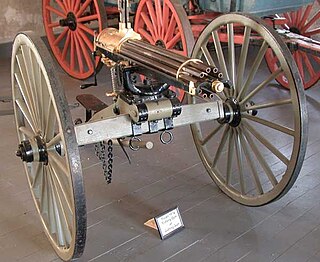
The Gatling gun is a rapid-firing multiple-barrel firearm invented in 1861 by Richard Jordan Gatling. It is an early machine gun and a forerunner of the modern electric motor-driven rotary cannon.

John Moses Browning was an American firearm designer who developed many varieties of military and civilian firearms, cartridges, and gun mechanisms – many of which are still in use around the world. He made his first firearm at age 13 in his father's gun shop and was awarded the first of his 128 firearm patents on October 7, 1879, at the age of 24. He is regarded as one of the most successful firearms designers of the 19th and 20th centuries and pioneered the development of modern repeating, semi-automatic, and automatic firearms.
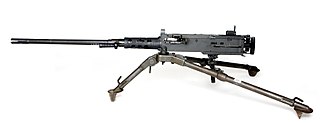
The M2 machine gun or Browning .50 caliber machine gun is a heavy machine gun designed toward the end of World War I by John Browning. Its design is similar to Browning's earlier M1919 Browning machine gun, which was chambered for the .30-06 cartridge. The M2 uses the much larger and much more powerful .50 BMG cartridge, which was developed alongside and takes its name from the gun itself. It has been referred to as "Ma Deuce", in reference to its M2 nomenclature. The design has had many specific designations; the official US military designation for the current infantry type is Browning Machine Gun, Cal. .50, M2, HB, Flexible. It is effective against infantry, unarmored or lightly armored vehicles and boats, light fortifications, and low-flying aircraft.

The .50 Browning Machine Gun is a .50 in (12.7 mm) caliber cartridge developed for the M2 Browning machine gun in the late 1910s, entering official service in 1921. Under STANAG 4383, it is a standard service cartridge for NATO forces as well as many non-NATO countries. The cartridge itself has been made in many variants: multiple generations of regular ball, tracer, armor-piercing (AP), incendiary, and saboted sub-caliber rounds. The rounds intended for machine guns are made into a continuous belt using metallic links.

The Maxim gun is a recoil-operated machine gun invented in 1884 by Hiram Stevens Maxim ; the weapon became the first automatic firearm in production by Vickers and also known as the first automatic firearm in the world, which used .303 British ammunition and a recoil-operating firing system, and required water cooling.

The Browning Automatic Rifle (BAR) is a family of US automatic rifles and machine guns used by the United States and numerous other countries during the 20th century. The primary variant of the BAR series was the M1918, chambered for the .30-06 Springfield rifle cartridge and designed by John Browning in 1917 for the American Expeditionary Forces in Europe as a replacement for the French-made Chauchat and M1909 Benét–Mercié machine guns that US forces had previously been issued.
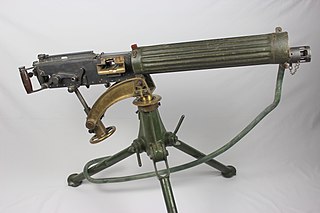
The Vickers machine gun or Vickers gun is a name primarily used to refer to the water-cooled .303 British (7.7 mm) machine gun produced by Vickers Limited, originally for the British Army. The machine gun typically required a six- to eight-man team to operate: one fired, one fed the ammunition, the rest helped to carry the weapon, its ammunition, and spare parts. Not to be confused with the Maxim machine gun, it was in service from before the First World War until the 1960s, with air-cooled versions of it on many Allied World War I fighter aircraft.
The M1917 Browning machine gun is a heavy machine gun used by the United States armed forces in World War I, World War II, the Korean War, and the Vietnam War; it has also been used by other nations. It was a crew-served, belt-fed, water-cooled machine gun that served alongside the much lighter air-cooled Browning M1919. It was used at the battalion level, and often mounted on vehicles. There were two main iterations: the M1917, which was used in World War I and the M1917A1, which was used thereafter. The M1917, which was used on some aircraft as well as in a ground role, had a cyclic rate of 450 rounds per minute. The M1917A1 had a cyclic rate of 450 to 600 rounds per minute.

A heavy machine gun or HMG is a belt-fed machine gun that fires full-powered/magnum cartridges and is designed to be significantly more massive than light, medium or general-purpose machine guns. As the name implies, heavy machine guns are typically not man-portable by infantry and thus require mounting onto a weapons platform to be operably stable or tactically mobile, have more formidable firepower, and generally require a team of personnel for operation and maintenance.
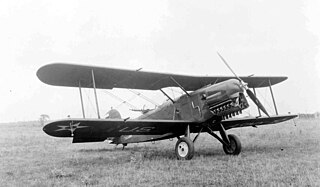
The Douglas XA-2 was an American prototype attack aircraft converted from a Douglas O-2 observation aircraft in the spring of 1926 by Douglas Aircraft. Only one prototype aircraft was built and the type was not ordered into production.
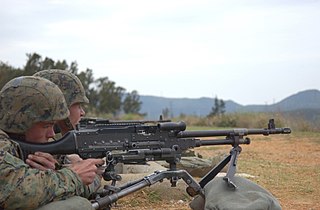
A medium machine gun (MMG), in modern terms, usually refers to a belt-fed machine gun firing a full-powered rifle cartridge, and is considered "medium" in weight. Medium machine guns are light enough to be infantry-portable, but still cumbersome enough to require a crew for optimal operational efficiency.
BMG may refer to:

The Colt–Browning M1895, nicknamed "potato digger" because of its unusual operating mechanism, is an air-cooled, belt-fed, gas-operated machine gun that fires from a closed bolt with a cyclic rate of 450 rounds per minute. Based on a John Browning and Matthew S. Browning design dating to 1889, it was the first successful gas-operated machine gun to enter service.
The M1921 Browning machine gun was a water-cooled .50-caliber machine gun, designed by John Moses Browning, which entered production in 1929.

The M1919 Browning is a .30 caliber medium machine gun that was widely used during the 20th century, especially during World War II, the Korean War, and the Vietnam War. The M1919 saw service as a light infantry, coaxial, mounted, aircraft, and anti-aircraft machine gun by the U.S. and many other countries.
References
- ↑ "Colt Browning M1895". 10 November 2010.